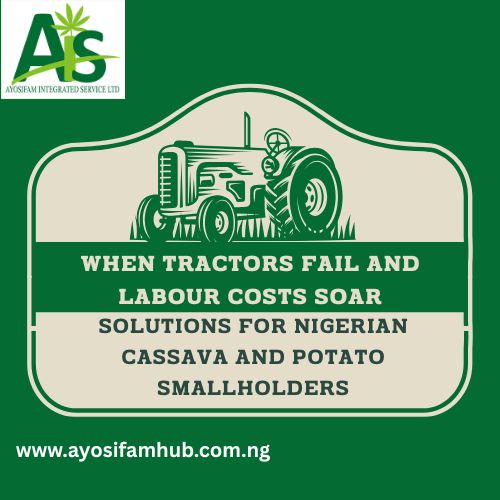For cassava and potato smallholder farmers in Nigeria, the intertwined challenges of unreliable tractor access and escalating labour costs can severely impact productivity and profitability. These farmers often operate on tight margins and rely on efficient and affordable land preparation, planting, weeding, and harvesting methods. Innovative and adaptive strategies become crucial for sustaining their livelihoods when their usual options falter.
Understanding the Challenges:
Tractor Failure and Limited Access: Tractors, while offering significant advantages in terms of speed and efficiency, are often plagued by breakdowns due to age, poor maintenance, and the challenging Nigerian terrain. Access can also be limited by availability, affordability of hiring services, and logistical hurdles, especially for farmers in remote areas.
High Labour Costs: Rural-urban migration, increased demand for agricultural labour during peak seasons, and general inflation contribute to the rising cost of manual labour. This can make labour-intensive farming practices economically unsustainable for smallholder farmers.
Navigating the Crisis: Practical Strategies for Smallholders
When faced with these constraints, cassava and potato farmers in Nigeria can adopt a multi-pronged approach:
1.Optimizing Existing Resources and Techniques:
Improved Manual Tools and Techniques: Investing in high-quality hoes, cutlasses, and other hand tools designed for efficiency can make manual labour less arduous. Farmers can also explore and adopt improved manual techniques for tasks like planting (e.g., using planting sticks with depth markers for potatoes, ensuring proper spacing for cassava cuttings), weeding (e.g., using hand-pushed weeders), and harvesting.
Conservation Agriculture Practices: Implementing conservation agriculture principles such as minimum tillage, crop rotation, and cover cropping can improve soil health and structure over time. This can lead to easier manual land preparation and potentially reduce the need for intensive tillage. For example, planting mucuna as a cover crop can suppress weeds and improve soil fertility, reducing the labour required for weeding and the need for extensive ploughing for the subsequent cassava or potato crop.
Staggered Planting and Harvesting: Instead of planting and harvesting the entire farm at once, staggering these activities can distribute the labour demand over a longer period, potentially making it more manageable with available family labour or reducing the need for a large, hired workforce at peak times.
Community-Based Solutions for Tool Sharing and Maintenance: Farmers can form cooperatives or groups to collectively purchase and maintain essential tools and equipment, including smaller motorized implements like power tillers or two-wheel tractors if feasible. Sharing knowledge on basic maintenance and repair can also reduce downtime and reliance on external technicians.
2.Exploring Sustainable and Intermediate Technologies:
Animal Traction: Where culturally appropriate and feasible, the use of animal traction (oxen or donkeys) for ploughing, harrowing, and transportation can be a viable alternative to tractors. While slower than tractors, animal power can be more affordable and readily available for some farmers. Training in animal handling and proper harnessing techniques is crucial for efficiency and animal welfare.
Small-Scale Mechanization: Investing in or accessing smaller, more affordable motorized implements like power tillers, two-wheel tractors with various attachments (plough, harrow, planter, harvester), and motorized sprayers can significantly improve efficiency for specific tasks without the high costs associated with full-sized tractors. Group ownership or rental schemes can make these technologies more accessible.
Intercropping and Agroforestry: Integrating compatible crops (intercropping) or trees (agroforestry) with cassava and potatoes can enhance land productivity and potentially reduce weeding requirements by providing ground cover. For instance, planting legumes between cassava rows can suppress weeds and fix nitrogen in the soil.
3.Leveraging Local Knowledge and Collaboration:
Learning from Experienced Farmers: Engaging with older, experienced farmers in the community can provide valuable insights into traditional farming practices and resource management strategies that may be effective in the current context.
Farmer Field Schools and Extension Services: Participating in farmer field schools and engaging with agricultural extension officers can provide access to information on improved farming techniques, pest and disease management, and sustainable practices.
Strengthening Farmer Cooperatives: Strong farmer cooperatives can facilitate collective bargaining for inputs, access to credit, and marketing of produce, potentially improving overall economic resilience. They can also explore joint ownership or rental of machinery.
4.Adapting Crop Management Practices:
Selecting Appropriate Varieties: Choosing cassava and potato varieties that are well-suited to the local environment, require less intensive cultivation practices (e.g., weed-competitive varieties), and offer good yields can help mitigate the impact of labour and machinery limitations.
Integrated Pest and Disease Management (IPM): Implementing IPM strategies that emphasize biological control, cultural practices, and targeted use of pesticides can reduce crop losses and the need for extensive interventions.
Efficient Harvesting Techniques: Exploring less labour-intensive harvesting methods, even manual ones, such as using specialized tools for lifting potatoes or employing strategic cutting techniques for cassava, can improve efficiency.
Policy and Support Considerations:
While farmers are actively seeking solutions, supportive policies and interventions are crucial:
Investing in Local Manufacturing and Repair of Agricultural Implements: Supporting local artisans and industries to produce affordable and durable hand tools and smaller motorized implements can improve access and reduce reliance on expensive imported machinery.
Promoting Sustainable Mechanization Models: Government and development organizations can support the establishment of machinery rental schemes, promote the use of animal traction where appropriate, and facilitate access to affordable financing for small-scale mechanization.
Strengthening Agricultural Extension Services: Well-funded and equipped extension services can play a vital role in disseminating information on improved farming practices, sustainable technologies, and climate-smart agriculture.
Investing in Rural Infrastructure: Improved road networks and transportation systems can reduce the cost of transporting inputs and produce, indirectly alleviating some of the economic pressures on farmers.
Conclusion:
The challenges of tractor failure and high labour costs present significant hurdles for cassava and potato smallholder farmers in Nigeria. However, by embracing a combination of optimized traditional practices, sustainable technologies, local knowledge, and collaborative efforts, these farmers can adapt and build more resilient and productive farming systems. Supportive policies and investments in local capacity and infrastructure are essential to facilitate this transition and ensure the long-term sustainability of Nigeria’s agricultural sector.




